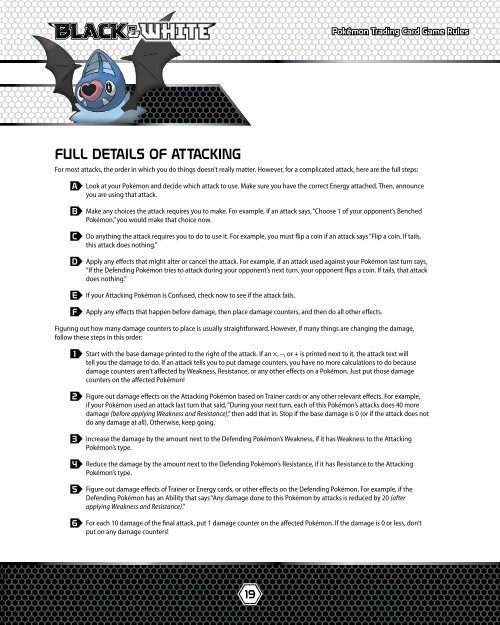Pokémon Trading Card Game Rules - Pokemon.com
Pokémon Trading Card Game Rules - Pokemon.com
Pokémon Trading Card Game Rules - Pokemon.com
You also want an ePaper? Increase the reach of your titles
YUMPU automatically turns print PDFs into web optimized ePapers that Google loves.
fuLL DeTAiLs of ATTACKinG<br />
19<br />
<strong>Pokémon</strong> <strong>Trading</strong> <strong>Card</strong> <strong>Game</strong> <strong>Rules</strong><br />
For most attacks, the order in which you do things doesn’t really matter. However, for a <strong>com</strong>plicated attack, here are the full steps:<br />
A<br />
B<br />
C<br />
D<br />
e<br />
f<br />
Look at your <strong>Pokémon</strong> and decide which attack to use. Make sure you have the correct Energy attached. Then, announce<br />
you are using that attack.<br />
Make any choices the attack requires you to make. For example, if an attack says, “Choose 1 of your opponent’s Benched<br />
<strong>Pokémon</strong>,” you would make that choice now.<br />
Do anything the attack requires you to do to use it. For example, you must flip a coin if an attack says “Flip a coin. If tails,<br />
this attack does nothing.”<br />
Apply any effects that might alter or cancel the attack. For example, if an attack used against your <strong>Pokémon</strong> last turn says,<br />
“If the Defending <strong>Pokémon</strong> tries to attack during your opponent’s next turn, your opponent flips a coin. If tails, that attack<br />
does nothing.”<br />
If your Attacking <strong>Pokémon</strong> is Confused, check now to see if the attack fails.<br />
Apply any effects that happen before damage, then place damage counters, and then do all other effects.<br />
Figuring out how many damage counters to place is usually straightforward. However, if many things are changing the damage,<br />
follow these steps in this order:<br />
1<br />
2<br />
3<br />
4<br />
5<br />
6<br />
Start with the base damage printed to the right of the attack. If an ×, –, or + is printed next to it, the attack text will<br />
tell you the damage to do. If an attack tells you to put damage counters, you have no more calculations to do because<br />
damage counters aren’t affected by Weakness, Resistance, or any other effects on a <strong>Pokémon</strong>. Just put those damage<br />
counters on the affected <strong>Pokémon</strong>!<br />
Figure out damage effects on the Attacking <strong>Pokémon</strong> based on Trainer cards or any other relevant effects. For example,<br />
if your <strong>Pokémon</strong> used an attack last turn that said, “During your next turn, each of this <strong>Pokémon</strong>’s attacks does 40 more<br />
damage (before applying Weakness and Resistance),” then add that in. Stop if the base damage is 0 (or if the attack does not<br />
do any damage at all). Otherwise, keep going.<br />
Increase the damage by the amount next to the Defending <strong>Pokémon</strong>’s Weakness, if it has Weakness to the Attacking<br />
<strong>Pokémon</strong>’s type.<br />
Reduce the damage by the amount next to the Defending <strong>Pokémon</strong>’s Resistance, if it has Resistance to the Attacking<br />
<strong>Pokémon</strong>’s type.<br />
Figure out damage effects of Trainer or Energy cards, or other effects on the Defending <strong>Pokémon</strong>. For example, if the<br />
Defending <strong>Pokémon</strong> has an Ability that says “Any damage done to this <strong>Pokémon</strong> by attacks is reduced by 20 (after<br />
applying Weakness and Resistance).”<br />
For each 10 damage of the final attack, put 1 damage counter on the affected <strong>Pokémon</strong>. If the damage is 0 or less, don’t<br />
put on any damage counters!


